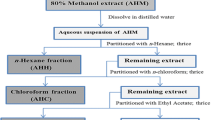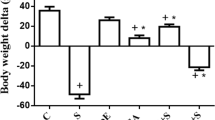Abstract
Protocatechuic acid ethyl ester (PCA), a phenolic compound, exhibits neuroprotective effects through improving endogenous antioxidant enzymatic and nonezymatic system. Based on the role of oxidative stress in modulating depressive disorders and the relationship between neuroprotective and antioxidant potential of PCA, we studied if its antidepressant like effect is associated by modulation of cerebral cortex and hippocampal antioxidant alterations. Acute restraint stress (ARS) is known to induce depressive like behavior by neuronal oxidative damage in mice. Swiss albino mice subjected to ARS exhibited an increased immobility time in forced swim test, elevated serum corticosterone and produced oxidative stress dependent alterations in cerebral cortex and hippocampus mainly increased thiobarbituric acid reactive substances and reduced catalase (CAT), superoxide dismutase (SOD) activity. Treatment with PCA was able to prevent stress induced immobility time in forced swim test without altering locomotor activity in mice. Further, PCA treatment attenuated the elevation of serum corticosterone, lipid peroxidation and restored enzymatic antioxidants in cerebral cortex and hippocampus in ARS mice. Altogether, the experimental findings demonstrate the notion that PCA exhibit antidepressant like activity might be related, at least in part, to its capability of modulating antioxidant defense system and oxidative damage induced by ARS in cerebral cortex and hippocampus in mice and thus maintain the pro−/anti-oxidative homeostasis.








Similar content being viewed by others
References
Aebi H (1984) Catalase in vitro Methods Enzymol 105:121–126
An LJ, Guan S, Shi GF, Bao YM, Duan YL, Jiang B (2006) Protocatechuic acid from Alpiniaoxyphylla against MPP + −induced neurotoxicity in PC12 cells. Food Chem Toxicol 44:436–443
Bettio LEB, Freitas AE, Neis VB, Santos DB, Ribeiro CM, Rosa RB (2014) Guanosine prevents behavioral alterations in the forced swimming test and hippocampal oxidative damage induced by acute restraint stress. Pharmacol Biochem Behav 127:7–14
Budni J, Zomkowski AD, Engel D, Santos DB, dos Santos A, Moretti M et al (2013) Folic acid prevents depressive-like behavior and hippocampal antioxidant imbalance induced by restraint stress in mice. Exp Neurol 240:112–121
Burri A, Maercker A, Krammer S, Simmen-Janevska K (2013) Childhood trauma and PTSD symptoms increase the risk of cognitive impairment in a sample of former indentured child laborers in old age. PLoS One 8:e57826
Buynitsky T, Mostofsky DI (2009) Restraint stress in biobehavioral research: recent developments. Neurosci Biobehav Rev 7:1089–1098
Calabrese F, Molteni R, Riva, MA, (2011) Antistress properties of antidepressant drugs and their clinical implications Pharmacol Ther 132:39–56
Capra JC, Cunha MP, Machado DG, Zomkowski AD, Mendes BG, Santos AR, Pizzolatti MG, Rodrigues AL (2010) Antidepressant-like effect of scopoletin, a coumarin isolated from Polygala sabulosa (Polygalaceae) in mice: evidence for the involvement of monoaminergic systems. Eur J Pharmacol 643:232–238
Christiansen SH, Olesen MV, Wortwein G, Woldbye DP (2011) Fluoxetine reverts chronic restrain stress induced depression like behavior and increase neuropeptide Y and galanin expression in mice. Behav Brain Res 216:585–591
Chrousos GP (2009) Stress and disorders of stress system. Nat Rev Endocrinol 5:374–381
Crupi R, Mazzon E, Marino A, La Spada G, Bramanti P, Cuzzocrea S, Spina E (2010) Melatonin treatment mimics the antidepressant action in chronic corticosterone-treated mice. J Pineal Res 49:123–129
de Balk RS, Bridi JC, Portella Rde L, Carvalho NR, Dobrachinski F et al (2010) Clomipramine treatment and repeated restraint stress alter parameters of oxidative stress in brain regions of male rats. Neurochem Res 35:1761–1770
Ellman GL (1959) Tissue sulfhydryl groups. Arch Biochem Biophys 82:70–72
Enache M, Van Waes V, Vinner E, Lhermitte M, Maccari S, Darnaudéry M (2008) Impact of an acute exposure to ethanol on the oxidative stress status in the hippocampus of prenatal restraint stress adolescent male rats. Brain Res 1191:55–62
Fontella FU, Siqueira IR, Vasconcellos AP, Tabajara AR, Netto CA, Dalmaz C (2005) Repeated restraint stress induces oxidative damage in rat hippocampus. Neurochem Res 30:105–111
Freitas AE, Bettio LEB, Neis VB, Santos DB, Ribeiro CM et al (2014) Agmatine abolishes restraint stress-induced depressive-like behavior and hippocampal antioxidant imbalance in mice. Prog Neuro-Psychopharmacol Biol Psych 50:143–150
Gold PW, Goodwin FK, Chrousos GP (1988) Clinical and biochemical manifestations of depression relation to the neurobiology of stress. N Engl J Med 319:413–420
Guan S, Bao YM, Jiang B, An LJ (2006) Protective effect of protocatechuic acid from Alpiniaoxyphylla on hydrogen peroxide-induced oxidative PC12 cell death. Eur J Pharmacol 538:73–79
Hammen C, Kim EY, Eberhart NK (2009) Brennan PA, (2009) chronic and acute stress and the prediction of major depression in women. Depress Anxiety 26:718–723
Jaggi AS, Bhatia N, Kumar N, Anand P, Dhavan R (2011) A review on animal models for screening potential anti-stress agents. Neurol Sci 32:993–1005
Jin P, Yu H, Tian-Lan, Zhang F, Quan Z (2015) Antidepressant-like effects of Oleoylethanolamide in a mouse model of chronic unpredictable mild stress. Pharmacol Biochem Behav 133:146–154
Jindal A, Mahesh R, Bhatt S (2013) Etazolate, a phosphodiesterase 4 inhibitor reverses chronic unpredictable mild stress-induced depression-like behavior and brain oxidative damage. Pharmacol Biochem Behav 105:63–70
Kalueff AV, Wheaton M, Murphy DL (2007) What’s wrong with my mouse model? Advances and strategies in animal modeling of anxiety and depression. Behav Brain Res 179:1–18
Kim JH, Kim GH, Hwang KH (2012) Monoamine oxidase and dopamine b-hydroxylase inhibitors from the fruits of Gardenia jasminoides. Biomol Ther 20:214–219
Kobayashi N, Machida T, Takahashi T, Takatsu H, Shinkai T, Abe K et al (2009) Elevation by oxidative stress and aging of hypothalamic-pituitary-adrenal activity in rats and its prevention by vitamin. Eur J Clin Biochem Nutr 45:207–213
Kumar A, Goyal R (2008) Quercetin protects against acute immobilization stress-induced behavior and biochemical alterations in mice. J Med Food 11:469–473
Kumar A, Garg R, Gaur V, Kumar P (2009) Nitric oxide mechanism in protective effect of imipramine and venlafaxine against acute immobilization stress induced behavioral and biochemical alteration in mice. Neurosci Lett 467:72–75
Lang UE, Borgwardt S (2013) Molecular mechanism of depression: perspective on new treatment strategies. Cell Physiol Biochem 31:761–777
Lee AL, Ogle WO, Sapolsky RM (2002) Stress and depression: possible links to neuron death in the hippocampus. Bipolar Disord 4:117–128
Lee B, Shim I, Lee HJ, Yang Y, Hahm DH (2009) Effects of acupuncture on chronic corticosterone-induced depression-like behavior and expression of neuropeptide Y in the rats. Neurosci Lett 453:151–156
Lin WL, Hsieh YJ, Chou FP, Wang CJ, Cheng MT, Tseng TH (2003) Hibiscus protocatechuic acid inhibits lipopolysaccharide-induced rat hepatic damage. Arch Toxicol 77:42–47
Lovell MA, Xie C, Markesbery WR (1998) Decreased glutathione transferase activity in brain and ventricular fluid in Alzheimer's disease. Neurol 51:1562–1566
Mao QQ, Huang Z, Zhong XM, Xian YF, Ip SP (2014) Piperine reverses the effects of corticosterone on behavior and hippocampal BDNF expression in mice. Neurochem Int 74:36–41
Mazure CM (1998) Life stressor as risk factors in depression. Clin Psychol Sci Pract 5:291–295
McKinnon MC, Yucel K, Nazarov A, MacQueen GM (2009) A meta-analysis examining clinical predictors of hippocampal volume in patients with major depressive disorder. J Psychiatry Neurosci 34:41–54
Mishra HP, Fridovich I (1972) Role of superoxide anion in auto-oxidation of epinephrine and a simple assay for superoxide dismutase. J Biol Chem 247:3170–3175
Moretti M, Budni J, Dos Santos DB, Antunes A, Daufenbach JF, Manosso LM (2013) Protective effects of ascorbic acid on behavior and oxidative staturs of restrint-stressed mice. J Mol Neurosci 49:68–79
Morris MC, Compas BE, Garber J (2012) Relations among posttraumatic stress disorder, comorbid major depression, and HPA function: a systematic review and meta-analysis. Clin Psychol Rev 32:301–315
Muley MM, Thakare VN, Patil RR, Kshirsagar AD, Naik SR (2012) Silymarin improves the behavioral, biochemical and histoarchitecture alterations in focal ischemic rats: comparative evaluation with piracetam and protocatachuic acid. Pharmacol Biochem Behav 102:286–293
Muley MM, Thakare VN, Patil RR, Bafna PA, Naik SR (2013) Amelioration of cognitive, motor and endogenous defense functions with silymarin, piracetam and protocatechuic acid in the cerebral global ischemic rat model. Life Sci 93:51–57
Naik SR, Thakare VN, Patil SR (2011) Protective effect of curcumin on experimentally induced inflammation, hepatotoxicity and cardiotoxicity in rats: evidence of its antioxidant property. Exp Toxicol Pathol 63:419–431
Niki E (2012) Do antioxidants impair signaling by reactive oxygen species and lipid oxidation products? FEBS Lett 586:767–770
Ohkawa H, Nobuko K (1979) Assay of lipid peroxide in animal tissue by thiobarbituric acid reaction. Anal Biochem 95:351–358
Ostadhadi S, Imran Khan M, Norouzi-Javidan A, Dehpour AR (2016) Antidepressant effect of pramipexole in mice forced swimming test: a cross talk between dopamine receptor and NMDA/nitric oxide/cGMP pathway. Biomed Pharmacother 81:295–304
Pacheco-Palencia LA, Mertens-Talcott S, Talcott ST (2008) Chemical composition, antioxidant properties, and thermal stability of phytochemical enriched oil from acai (Euterpeoleracea Mart). J Agric Food Chem 56:4631–4636
Porsolt RD, Bertin A, Jalfre M (1977) Behavioral despair in mice: a primary screening test for antidepressants. Arch Int Pharmacodyn Ther 229:327–336
Rang HP, Dale MM, Ritter JM, Flower RJ (2007) Selective serotonin reuptake inhibitors pharmacology, pp 566 Churchill Livingstone. Publication, Elsevier
Ressler KJ, Nemeroff CB (2000) Role of serotonergic and noradrenergic systems in the pathophysiology of depression and anxiety disorders. Depress Anxiety 12(S1):2–19
Rodrigues ALS, Rocha JB, Mello CF, Souza DO (1996) Effect of perinatal lead exposure on rat behavior in open-field and two-way avoidance tasks. Pharmacol Toxicol 79:150–156
Rosa JM, Dafre AL, Rodrigues AL (2013) Antidepressant like responses in the forced swimming test elicited by glutathione and redox modulation. Behav Brain Res 253:165–172
Sarandol A, Sarandol E, Eker SS, Erdinc S, Vatansever E, Kirli S (2007) Major depressive disorder is accompanied with oxidative stress: short-term antidepressant treatment does not alter oxidative-antioxidative systems. Humanist Psychol 22:67–73
Shi GF, An LJ, Jiang B, Guan SI, Bao YM (2006) Alpinia protocatechuic acid protects against oxidative damage in vitro and reduces oxidative stress in vivo. Neurosci Lett 403:206–210
Thakare VN, Patel BM (2015) Potential targets for the development of novel antidepressants: future perspectives. CNS Neurol Disord Drug Targets 14:270–281
Thakare VN, Dhakane VD, Patel BM (2016) Potential antidepressant-like activity of silymarin in the acute restraint stress in mice: modulation of corticosterone and oxidative stress response in cerebral cortex and hippocampus. Pharmacol Rep 68:1020–1027
Zafir A, Banu N (2007) Antioxidant potential of fluoxetine in comparision to Curcuma longa in restrint-stressed rats. Eur J Pharmacol 572:23–31
Zafir A, Ara A, Banu N (2009) In vivo antioxidant status: a putative target for antidepressant action. Prog Neuro-Psychopharmacol Biol Psychiatry 33:220–228
Zhang YJ, Wu L, Zhang QL, Li J, Yin FX, Yuan Y (2011) Pharmacokinetics of phenolic compounds of Danshen extract in rat blood and brain by microdialysis sampling. J Ethnopharmacol 136:129–136
Zhang H, Li G, Szeto S, Chong C, Quan Q et al (2015) Examining the neuroprotective effects of protocatechuic acid and chrysin on in vitro and in vivo models of Parkinson's disease. Free Radic Biol Med 84:331–333
Zhao Y, Xie W, Dai J, Wang Z, Huang Y (2009) The varying effects of short-term and long-term corticosterone injections on depression-like behavior in mice. Brain Res 1261:82–90
Acknowledgments
Authors are grateful to Prof. M. N. Navale, Founder President, Sinhgad Technical Education Society, Dr. R. N. Kane, Principal, and Rajesh R Patil, Sinhgad Institute of Pharmaceutical Sciences for providing necessary facilities, encouragement and support in the completion of present research studies.
Author information
Authors and Affiliations
Corresponding author
Ethics declarations
Conflict of interest
The authors declare that there are no conflicts of interest.
Rights and permissions
About this article
Cite this article
Thakare, V.N., Dhakane, V.D. & Patel, B.M. Attenuation of acute restraint stress-induced depressive like behavior and hippocampal alterations with protocatechuic acid treatment in mice. Metab Brain Dis 32, 401–413 (2017). https://doi.org/10.1007/s11011-016-9922-y
Received:
Accepted:
Published:
Issue Date:
DOI: https://doi.org/10.1007/s11011-016-9922-y




